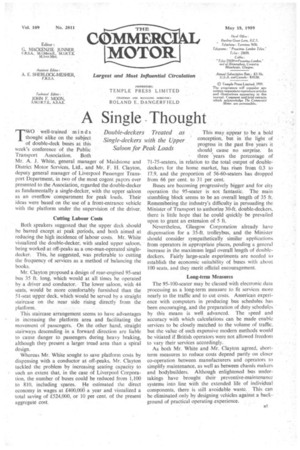A Single Thought
Page 39

If you've noticed an error in this article please click here to report it so we can fix it.
TWO well-trained minds thought alike on the subject of double-deck buses at this week's conference of the Public Transport Association. Both Mr. A. J. White, general manager of Maidstone and District Motor Services, Ltd., and Mr. F. H. Clayton, deputy general manager of Liverpool Passenger Transport Department, in two of the most cogent papers ever presented to the Association, regarded the double-decker as fundamentally a single-decker, with the upper saloon as an overflow compartment for peak loads. Their ideas were based on the' use of a front-entrance vehicle with the platform under the supervision of the driver.
• Cutting Labour Costs • Both speakers suggested that the upper deck should be barred except at peak periods, and both aimed at reducing the high incidence of labour costs. Mr. White visualized the double-decker, with sealed upper saloon, • being worked at off-peaks as a one-man-operated singledecker. This, he suggested, was preferable to cutting the frequency of services as a method of balancing the books.
Mr. Clayton proposed a ,design of rear-engined 95-seat bus 35 ft. long, which would at all times be operated by a driver and conductor. The lower saloon, with 44 seats, would be more comfortably furnished than the 51-seat upper deck, which would be served by a straight staircase on the near side rising directly from the platform.
This staircase arrangement seems to have advantages in increasing the platform area and facilitating the movement of passengers. On the other hand, straight stairways descending in a forward direction are liable to cause danger to passengers during heavy braking, although they present a larger tread area than a spiral design.
Whereas Mr. White sought to• save platform costs by dispensing with a conductor at off-peaks, Mr. Clayton tackled the problem by increasing seating capacity to such an extent that, in the case of Liverpool Corporation, the number of buses could be reduced from 1,100 to 810, including spares. He estimated the direct economy in wages at £400,005 a year and visualized a total saving of £524,000, or 10 per cent, of the present aggregate cost. This may appear to be a bold conception, but in the light of progress in the past five years it should cause no surprise. In three years the percentage of 71-75-seaters, in relation to the total output of doubledeckers for the home market, has risen from 0.3 to 17.9, and the proportion of 56-60-seaters has dropped from 66 per cent. to 31 per cent.
Buses are becoming progressively bigger and for city operation the 95-seater is not fantastic. The main stumbling block seems to be an overall length of 35 ft. Remembering the industry's difficulty in persuading the Minister of Transport to authorize 30-ft. double-deckers, there is little hope that he could quickly be prevailed upon to grant an extension of 5 ft.
Nevertheless, Glasgow Corporation already have dispensation for a 35-ft. trolleybus, and the Minister should consider sympathetically similar applications from operators in appropriate places, pending a general increase in the maximum legal overall length of doubledeckers. Fairly large-scale experiments are needed to establish the economic suitability of buses with about 100 seats, and they merit official encouragement.
Long-term Measures The 95-100-seater may be classed with electronic data processing as a long-term measure to fit services more nearly to the traffic and to cut costs. American experience with computers in producing bus schedules has been encouraging, and the preparation of duty schedules by this means is well advanced. The speed and accuracy with which calculations can be made enable services to be closely matched to the volume of traffic, but the value of such expensive modern methods would be vitiated if British operators were not allowed freedom to vary their services accordingly.
As both Mr. White and Mr. Clayton agreed, shortterm measures to reduce costs depend partly on closer co-operation between manufacturers and operators to simplify maintenance, as well as between chassis makers and bodybuilders. Although enlightened bus undertakings have brought their preventive-maintenance systems into line with the extended life of individual components, there is still avoidable• waste. This can be eliminated only by designing vehicles against a background of practical operating experience.




















































































































